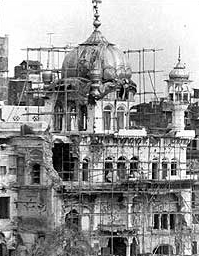Akal Takht
From Wikipedia, the free encyclopedia
(Redirected from Sri Akal Takht Sahib)
| This article may require copy editing for clarity and grammar. (July 2013) |
| The Akal Takht ਅਕਾਲ ਤਖ਼ਤ ਸਾਹਿਬ | |
|---|---|

The Akal Takht
| |
| General information | |
| Architectural style | Sikh architecture |
| Town or city | Amritsar |
| Country | India |
The Akal Takht (Punjabi: ਅਕਾਲ ਤਖ਼ਤ; meaning The Throne of the Timeless One)[1] is the highest seat of temporal authority of the Khalsa. The Akal Takht is located in the Harmandir Sahib complex in Amritsar, Punjab. It was built by theGuru Hargobind Sahib and it stands as a witness to the Sikh idea of sovereignty. It symbolizes the interlocking of the temporal with the spiritual in Sikhism[1]
Contents
[hide]History[edit]
The Akal Takht was built by the sixth Sikh Guru, Guru Hargobind Ji as a symbol for political sovereignty of Sikhs. It was established as the place from which the spiritual and temporal concerns of the Sikh people could be acted upon. It stood as a symbol of political and military resistance against the tyranny and cruelty of the 17th- and 18th-century rulers. In the 18th century,Ahmed Shah Abdali led a series of attacks on the Akal Takht and Harmandir Sahib.[1] Akal Takht Sahib represents the sovereignty of the Sikh Nation. It stood as a symbol of political bulwark against the Mughal emperors in the 17th and 18th century. Various attacks on the Akal Takht and Harimandir Sahib have been led in past by Ahmed Shah Abdali and Massa Rangar in the 18th century. On June 4, 1984, the Akal Takht was badly damaged when the Indian Army stormed Sri Darbar Sahib during Operation Bluestar. The Jathedar of the Akal Takhat is the highest spokesperson of the Sikh religion. Khande-Bate-Dee-Pahul or the initiation with the sword, initiated by Guru Gobind Singh, continues to be routinely performed at the Akal Takht. Hari Singh Nalwa, a General under Maharaja Ranjit Singh the leader of the Sikh Kingdom, wished to make the Akal Takht resplendent with gold and had donated a part of his wealth for this purpose.[2]
It is the most supreme of all the Takhts. The four other takhats are
Architecture[edit]
On the original plot of land of the Akal Takhat, there only existed a high mound of earth across a wide open space, where Guru Hargobind as a child used to play. The Gurus original Takhat is said to have been a simple platform, 3.5 metres high, on which the Guru would sit like a king at court, surrounded by insignia of royalty such as the parasol and the flywhisk, and perform kingly tasks of receiving petitions and administrating justice. Today’s Akal Takhat is a large 5-storey modern structure (3 storeys were added by Maharaja Ranjit Singh) with inlaid marble and a gold-leafed dome, that does not convey the design of Guru Hargobind’s simple Takht or plinth. However, recent restoration work has uncovered a layer of lime plaster, with painted decoration, that may have been part of the original Takhat. That plinth was higher than the plinth of the Harimandir; yet the absence of a superstructure kept the original Akal Takhat at a level lower than the shrine.
The elaboration of the structure on marble pillars, as a semi-circular platform with an open view to the courtyard, reminiscent of an air-house, must have grown from the use to which the Durbar hall was put.
The gilding of the ceiling with ornamentations like those in the interior of the Hari Mandir Sahib is perhaps later than in the holy of holies. The wall paintings belong to a later period, as there are panels showing Europeans.
The total effect of the Akal Takhat and the open courtyard, in front of the Darshani Deori and the viewa of the Amritsar beyond, is of a unique and noble structure .
1984: Damage to Akal Takht during Operation Blue Star[edit]
The Akal Takht was badly damaged during the assault on the Golden Temple by the Indian army in June 1984.[3][4] On June 6, 1984 theIndian Army stormed the Golden Temple complex, even bringing its tanks into the Parikrama during the Operation Blue Star. Operation Blue Star was an Indian military operation, ordered by Indira Gandhi, then Prime Minister of India, to stop and suppress Jarnail Singh Bhindarwale.[further explanation needed]
In 2005, Prime Minister Manmohan Singh acknowledged some of the failures and apologized to the Sikh community.
"I have no hesitation in apologizing not only to the Sikh community but to the whole nation, because what took place in 1984 is a negation of the concept of nationhood enshrined in our Constitution, The past is behind us. We cannot change it, but we can write the future. We must have the will power to write a better future for all of us."[5]
Re-building of the Akal Takht[edit]
At first the Akal Takht was rebuilt by contractors of the Indian Government. A few Sikhs were then excommunicated from Sikhism, for what Sikhs saw as siding with the Indian Government. The rebuilt Akal Takht became known as the 'Sarkari Takht' - Sarkari meaning one of the Government and not one of Akal (meaning Immortal and related to Sikh religion).
Buta Singh who was appointed home minister in the Rajiv Gandhi Cabinet was excommunicated from the Sikh Panth for his role in rebuilding a 'sarkari' Akal Takht after Operation Blue Star. He finally had to undergo the 'punishment' of cleaning the devotees's utensils and shoes at the Golden Temple for being taken back into the faith.[6]




No comments:
Post a Comment